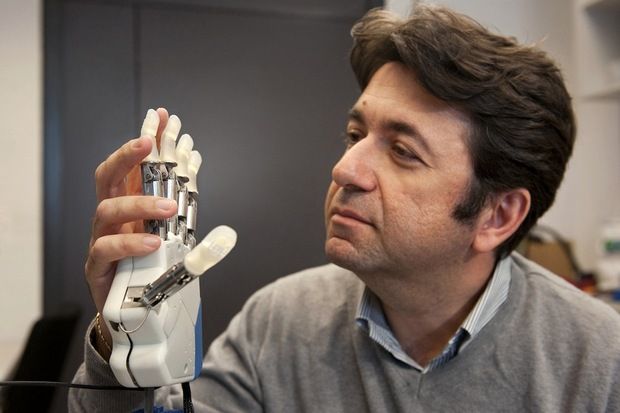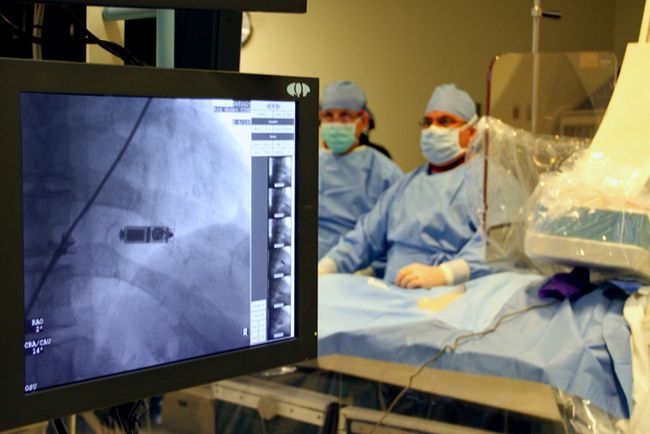作者:Jim Lucas,Live Science撰稿人 | 發表於 2014/09/25 01:01am
By Jim Lucas, Live Science Contributor | September 25, 2014 01:01am ET
 席威斯特洛夫.米切拉,一名帶領團隊開發擁有觸覺的仿生手的神經工程師。(圖片: ©洛桑聯邦理工學院/西拉里庇護所)
Silvestro Micera, a neural engineer, led a team that developed a bionic hand that can feel. (Image: © EPFL / Hillary Sanctuary)
席威斯特洛夫.米切拉,一名帶領團隊開發擁有觸覺的仿生手的神經工程師。(圖片: ©洛桑聯邦理工學院/西拉里庇護所)
Silvestro Micera, a neural engineer, led a team that developed a bionic hand that can feel. (Image: © EPFL / Hillary Sanctuary)
生物醫學工程,或著生醫工程,是一門將工程原則應用至生物及醫療照護領域的一門學科。生醫工程師會與醫生、治療師和研究者一起工作,開發
用於解決臨床問題的系統、設備和裝置。
Biomedical engineering, or bioengineering, is the application of engineering principles to the fields of biology and health care. Bioengineers work with doctors, therapists and researchers to develop systems, equipment and devices in order
to solve clinical problems.
生物醫學工程師們已經開發出一些能夠
提升安全和救命的技術。包括這些:
Biomedical engineers have developed a number of
life-enhancing and life-saving technologies. These include:
- Prosthetics, such as dentures and artificial limb replacements.
- Surgical devices and systems, such as robotic and laser surgery.
- Systems to monitor vital signs and blood chemistry.
- Implanted devices, such as insulin pumps, pacemakers and artificial organs.
- Imaging methods, such as ultrasound, X-rays, particle beams and magnetic resonance.
- Diagnostics, such as lab-on-a-chip and expert systems.
- Therapeutic equipment and devices, such as kidney dialysis and transcutaneous electrical nerve stimulation (TENS).
- Radiation therapy using particle beams and X-rays.
- Physical therapy devices, such as exercise equipment and wearable tech.
生物醫學工程擁有悠久的實踐歷史。最早的例子之一是在有3000年歷史的埃及木乃伊身上發現的,一個用木頭和皮革做成的
假腳趾頭。在那之前,
即使是簡單的枴杖和手杖也被視為工程型輔助器材,還有第一個使用夾板方式夾住骨折處的骨頭的人,亦被視為早期的生醫工程師。
The practice of biomedical engineering has a long history. One of the earliest examples is a wood and leather
prosthetic toe found on a 3,000-year-old Egyptian mummy. Before that,
even simple crutches and walking sticks were a form of engineered assistive devices, and the first person to fashion a splint for a broken bone could be considered to have been an early biomedical engineer.
生物醫學工程多年來一直在發展並呼應科學與科技方面的進步。縱觀歷史,人們一直在開發日益便捷的裝置來診斷和治療疾病,並減輕、復健或代償殘疾或受傷。
透過放大音頻來幫助聽力損失的助聽器的演進便是其中一個例子。根據助聽器博物館的說法,直到20世紀中為止,
掛在耳朵上的大型喇叭型裝置的助聽筒,是唯一能輔助聽力的"可行方式"。博物館在其網站中提到,雖然在那之前電子設備就已經開發出來,但是速度很慢而無法實用。
Biomedical engineering has evolved over the years in response to advancements in science and technology. Throughout history, humans have made increasingly more effective devices to diagnose and treat diseases and to alleviate, rehabilitate or compensate for disabilities or injuries.
One example is the evolution of hearing aids to mitigate hearing loss through sound amplification. The
ear trumpet, a
large horn-shaped device that was held up to the ear, was the only “viable form” of hearing assistance until the mid-20th century, according to the Hearing Aid Museum. Electrical devices had been developed before then, but were slow to catch on, the museum said on its website.
亞歷山大.格拉漢姆.貝爾(Alexander Graham Bell)和
湯瑪斯.愛迪生(Thomas Edison)兩人在19世紀晚期和20世紀初期對聲音的傳播與放大的研究,促使第一台桌上型助聽器問世。接著出現了第一台使用真空管放大器及巨型電池的可攜式(或"手提式")裝置。
然而,第一台可穿戴的助聽器要等到貝爾實驗室的威廉.肖克利(William Shockley)與他的團隊開發出電晶體才出現。仰賴微積體電路的後續發展和電池技術的進步讓助聽器得以縮小體積到能夠塞進耳道裡。
The works of
Alexander Graham Bell and
Thomas Edison on sound transmission and amplification in the late 19th and early 20th centuries were applied to make the first tabletop hearing aids. These were followed by the first portable (or “luggable”) devices using vacuum-tube amplifiers powered by large batteries.
However, the first wearable hearing aids had to await the development of the transistor by William Shockley and his team at Bell Laboratories. Subsequent development of micro-integrated circuits and advance battery technology has led to miniature hearing aids that fit entirely within the ear canal.
這些是歷來在生物醫學工程領域中著名的人物和他們的貢獻,包括:
Some notable figures in the history of biomedical engineering and their contributions include:
教學要求 Educational requirements
生物醫學工程師設計和開發醫用系統、設備和裝置。根據
美國勞工統計局(BLS),這同時需要熟知器材的操作原則(電子、化學、生物等)相關知識,同時還需要知道應用會如何被使用。
舉例來說,為了設計一個人工心臟,一名工程師必須對電子工程、機械工程和流體力學有廣泛的認知之外,同時也需要對心臟學和生理學有深入的了解。設計一個實驗室晶片需要電子、奈米技術、材料科學和生物化學等知識。而為了設計替換式假肢,則需要機械工程和材料特性的專業知識之外,同時生物化學及生理學的知識亦是必不可少的。
Biomedical engineers design and develop medical systems, equipment and devices. According to the
U.S. Bureau of Labor Statistics (BLS), this requires in-depth knowledge of the operational principles of the equipment (electronic, mechanical, biological, etc.) as well as knowledge about the application for which it is to be used.
For instance, in order to design an artificial heart, an engineer must have extensive knowledge of electrical engineering, mechanical engineering and fluid dynamics as well as an in-depth understanding of cardiology and physiology. Designing a lab-on-a-chip requires knowledge of electronics, nanotechnology, materials science and biochemistry. In order to design prosthetic replacement limbs, expertise in mechanical engineering and material properties as well as biomechanics and physiology is essential.
一名生醫工程師所需的關鍵技能包含對於幾個工程領域和具體的應用領域的全面了解。
這可能包括學習生理學、有機化學、生物化學或電腦科學。為了跟上科技進步以及潛在的新應用,持續教育與培訓也是必要的。
The critical skills needed by a biomedical engineer include a well-rounded understanding of several areas of engineering as well as the specific area of application.
This could include studying physiology, organic chemistry, biomechanics or computer science. Continuing education and training are also necessary to keep up with technological advances and potential new applications.
 俄亥俄州立大學維克斯納醫學中心的約翰.胡默爾醫師(左)和拉爾夫.奧古斯汀是在美國率先植入世界最小的心律調節器的團隊之一。心律調節器被設計用於監測患者的心臟,且只有在需要時才啟動,大小大約只有4號電池的一半。裝入後使用壽命預計可長達14年。(圖片來源:俄亥俄州立大學維克斯納醫學中心)
Dr. John Hummel (left) and Dr. Ralph Augostini of The Ohio State University Wexner Medical Center are among the first in the U.S. to implant the world’s smallest pacemaker. Roughly half the size of a AAA battery, the pacemaker is designed to monitor the patient’s heart and only activate when needed. It is expected to last up to 14 years.(Image credit: Ohio State University Wexner Medical Center)
俄亥俄州立大學維克斯納醫學中心的約翰.胡默爾醫師(左)和拉爾夫.奧古斯汀是在美國率先植入世界最小的心律調節器的團隊之一。心律調節器被設計用於監測患者的心臟,且只有在需要時才啟動,大小大約只有4號電池的一半。裝入後使用壽命預計可長達14年。(圖片來源:俄亥俄州立大學維克斯納醫學中心)
Dr. John Hummel (left) and Dr. Ralph Augostini of The Ohio State University Wexner Medical Center are among the first in the U.S. to implant the world’s smallest pacemaker. Roughly half the size of a AAA battery, the pacemaker is designed to monitor the patient’s heart and only activate when needed. It is expected to last up to 14 years.(Image credit: Ohio State University Wexner Medical Center)
生醫工程師薪水 Biomedical engineer salary
根據美國勞統局,大部分生醫工程師的工作至少需要生物醫學工程領域的學士學位。許多求職者亦需要認證來證明其為專業的工程師。而通常需要碩士學位才能升遷至管理階層,並且需要持續的教育和培訓來跟上技術、測試和監測設備、電腦硬體和軟體以及政府法規的進步。
Most biomedical engineering jobs require at least a bachelor’s degree in biomedical engineering, according to the BLS. Many employers also require state certification as a professional engineer. A master’s degree is often required for promotion to management, and ongoing education and training are needed to keep up with advances in technology, testing and monitoring equipment, computer hardware and software, and government regulations.
根據美國
Salary.com網站,截至2014年7月的薪資範圍,一個剛畢業有學士學位的生醫工程師的薪水是35,213美元至64,371美元。有碩士學位和5至10年經驗的中級工程師薪水範圍在51,404美元至84,098美元;而具有碩士或博士學位的和超過15年經驗的高級工程師薪水範圍在82,490美元至112,063美元。許多有高等學位且經驗豐富的工程師在晉升至管理職位時甚至可以得到更多的收入。
According to
Salary.com, as of July 2014 the salary range for a newly graduated biomedical engineer with a bachelor’s degree is $35,213 to $64,371. The range for a mid-level engineer with a master’s degree and five to 10 years of experience is $51,404 to $84,098; and the range for a senior engineer with a master’s degree or doctorate and more than 15 years of experience is $82,490 to $112,063. Many experienced engineers with advanced degrees are promoted to management positions where they can earn even more.
生醫工程的未來是什麼? What is the future of biomedical engineering?
美國勞統局預計,從2012至2022年,生醫工程師的就業人數將增長27%,比其他所有職業平均速度還要快。根據美國勞統局,
由於老化人口很可能需要越來越多的醫療照護,和提高公眾對生物醫學工程進展及其益處的認識等原因,此職業的人力需求將會壯大許多。
The BLS projects that employment of biomedical engineers will grow 27 percent from 2012 to 2022, much faster than the average for all occupations.
Demand will be strong because an aging population is likely to need more medical care and because of increased public awareness of biomedical engineering advances and their benefits, according to the BLS.
Jim Lucas是一位專攻物理學、天文學和工程學的自由撰稿人。同時是Lucas Technologies的總經理。
Jim Lucas is a freelance writer and editor specializing in physics, astronomy and engineering. He is general manager of Lucas Technologies.
其他資源 Additional resources


留言
張貼留言